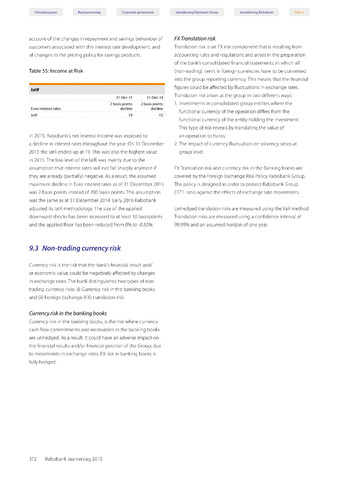9.3 Non-trading currency risk
Inhoudsopgave Bestuursverslag Corporate governance
account of the changes in repayment and savings behaviour of
customers associated with this interest rate development, and
of changes to the pricing policy for savings products.
Table 55: Income at Risk
latR
31 -Dec-15
31-Dec-14
2 basis points
2 basis points
Euro interest rates
decline
decline
latR
19
15
In 2015, Rabobank's net interest income was exposed to
a decline in interest rates throughout the year. On 31 December
2015 the latR ended up at 19. This was also the highest value
in 2015.The low level of the latR was mainly due to the
assumption that interest rates will not fall sharply anymore if
they are already (partially) negative. As a result, the assumed
maximum decline in Euro interest rates as of 31 December 2015
was 2 basis points instead of 200 basis points.This assumption
was the same as at 31 December 2014. Early 2016 Rabobank
adjusted its latR methodology. The size of the applied
downward shocks has been increased to at least 10 basispoints
and the applied floor has been reduced from 0% to -0.50%.
Jaarrekening Rabobank Groep Jaarrekening Rabobank
FX Translation risk
Translation risk is an FX risk component that is resulting from
accounting rules and regulations and arises in the preparation
of the bank's consolidated financial statements, in which all
(non-trading) items in foreign currencies have to be converted
into the group reporting currency. This means that the financial
figures could be affected by fluctuations in exchange rates.
Translation risk arises at the group in two different ways:
1. Investments in consolidated group entities where the
functional currency of the operation differs from the
functional currency of the entity holding the investment.
This type of risk reveals by translating the value of
an operation to Euros;
2. The impact of currency fluctuation on solvency ratios at
group level.
FX Translation risk and currency risk in the Banking books are
covered by the Foreign Exchange Risk Policy Rabobank Group.
The policy is designed in order to protect Rabobank Group
CET1 ratio against the effects of exchange rate movements.
Unhedged translation risks are measured using the VaR method.
Translation risks are measured using a confidence interval of
99.99% and an assumed horizon of one year.
Currency risk is the risk that the bank's financial result and/
or economic value could be negatively affected by changes
in exchange rates. The bank distinguishes two types of non-
trading currency risks: (i) Currency risk in the banking books
and (ii) Foreign Exchange (FX) translation risk.
Currency risk in the banking books
Currency risk in the banking books, is the risk where currency
cash flow commitments and receivables in the banking books
are unhedged. As a result, it could have an adverse impact on
the financial results and/or financial position of the Group, due
to movements in exchange rates. FX risk in banking books is
fully hedged.
372 Rabobank Jaarverslag 2015

